Testing Mechanical Properties of Rock Bolt under Different Supports Using Fiber Bragg Grating Technology
Abstract
:1. Introduction
2. FBG Sensor
2.1. Advantages of FBG in Bolt Monitoring
2.2. Brief Introduction to the FBG Sensor
2.3. FBG Sensor Installation
2.4. Data Interpretation
3. Rock Bolt Mechanism and Experiment Condition Design
3.1. Action Mechanism of the Prestressed Anchor
3.2. Mechanism of the Non-Prestressed Anchor
3.3. Design of Experiment Condition
4. Experimental Materials and Processes
5. Experimental Results and Analyses
6. Conclusions and Future Work
Author Contributions
Funding
Conflicts of Interest
References
- Benmokrane, B.; Chekired, M.; Xu, H. Monitoring behavior of grouted anchors using vibrating-wire gauges. J. Geotech. Eng. 1995, 121, 466–475. [Google Scholar] [CrossRef]
- Cheng, L. Research and new progress in ground anchorage. Chin. J. Rock Mech. Eng. 2005, 24, 3803–3811. (In Chinese) [Google Scholar]
- Petersen, D.; Lin, Z.; Zhao, J. Design of anchor reinforcement for seismic tension loads. Eng. Struct. 2018, 164, 109–118. [Google Scholar] [CrossRef]
- Oktavianus, Y.; Chang, H.; Goldsworthy, H.M.; Gad, E.F. Component model for pull-out behaviour of headed anchored blind bolt within concrete filled circular hollow section. Eng. Struct. 2017, 148, 210–224. [Google Scholar] [CrossRef]
- Kilic, A.; Yasar, E.; Celik, A.G. Effect of grout properties on the pullout load capacity of fully grouted rock bolt. Tunn. Undergr. Space Technol. 2002, 17, 355–362. [Google Scholar] [CrossRef]
- Kilic, A.; Yasar, E.; Atis, C.D. Effect of bar shape on the pull-out capability of fully-grouted rockbolts. Tunn. Undergr. Space Technol. 2003, 18, 1–6. [Google Scholar] [CrossRef]
- Campoli, A.; Mills, P.; Todd, P.; Dever, K. Resin annulus size effects on rebar bolt pull strength and resin loss to fractured rock. In Proceedings of the 18th International Conference on Ground Control in Mining, Morgantown, WV, USA, 3–5 August 1999. [Google Scholar]
- Farmer, I.W. Stress distribution along a resin grouted rock anchor. Int. J. Rock Mech. Min. Sci. Geomech. Abstr. 1975, 12, 347–351. [Google Scholar] [CrossRef]
- Freeman, T.J. The behaviour of fully-bonded rock bolts in the kielder experimental tunnel. Tunn. Tunn. 1978, 10, 37–40. [Google Scholar]
- Gamboa, E.; Atrens, A. Environmental influence on the stress corrosion cracking of rock bolts. Eng. Fail. Anal. 2003, 10, 521–558. [Google Scholar] [CrossRef]
- Li, H.-N.; Li, D.-S.; Song, G. Recent applications of fiber optic sensors to health monitoring in civil engineering. Eng. Struct. 2004, 11, 1647–1657. [Google Scholar] [CrossRef]
- Li, W.; Luo, M.; Huynh, Q.; Ho, S.C.M.; Song, G. Fiber optic macro-bend based sensor for detection of metal loss. Smart Mater. Struct. 2017, 26, 045002. [Google Scholar] [CrossRef]
- Sun, M.; Staszewski, W.J.; Swamy, R.N. Smart Sensing Technologies for Structural Health Monitoring of Civil Engineering Structures. Adv. Civ. Eng. 2010, 11, 13. [Google Scholar] [CrossRef]
- Hill, K.O.; Meltz, G. Fiber Bragg Grating Technology Fundamentals and Overview. J. Lightw. Technol. 1997, 15, 1263–1276. [Google Scholar] [CrossRef]
- Lee, B. Review of the present status of optical fiber sensors. Opt. Fiber Technol. 2003, 9, 57–79. [Google Scholar] [CrossRef]
- Li, D.S.; Li, H.; Ren, L.; Song, G. Strain transferring analysis of fiber Bragg grating sensors. Opt. Eng. 2006, 45, 024402. [Google Scholar] [CrossRef]
- Ho, S.C.M.; Razavi, M.; Nazeri, A.; Song, G. FBG sensor for contact level monitoring and prediction of perforation in cardiac ablation. Sensors 2012, 12, 1002–1013. [Google Scholar] [CrossRef] [PubMed]
- Ho, S.C.M.; Li, W.; Razavi, M.; Song, G.; Ho, M. Fiber Bragg grating based arterial localization device. Smart Mater. Struct. 2017, 26, 065020. [Google Scholar] [CrossRef]
- Li, W.; Ho, S.C.M.; Song, G. Corrosion detection of steel reinforced concrete using combined carbon fiber and fiber Bragg grating active thermal probe. Smart Mater. Struct. 2016, 25, 045017. [Google Scholar] [CrossRef]
- Li, H.N.; Song, G.B.; Li, D.S.; Ren, L. Structural Health Monitoring of a Tall Building during Construction with Fiber Bragg Grating Sensors. Int. J. Distrib. Sens. Netw. 2012, 8, 272190. [Google Scholar] [CrossRef]
- Zhao, X.; Gou, J.; Song, G.; Ou, J. Strain monitoring in glass fiber reinforced composites embedded with carbon nanopaper sheet using Fiber Bragg Grating (FBG) sensors. Compos. Part B 2009, 40, 134–140. [Google Scholar] [CrossRef]
- Hou, Q.; Jiao, W.; Ren, L.; Cao, H.; Song, G. Experimental study of leakage detection of natural gas pipeline using FBG based strain sensor and least square support vector machine. J. Loss Prev. Process Ind. 2014, 32, 144–151. [Google Scholar] [CrossRef]
- Ren, L.; Jia, Z.-G.; Li, H.-N.; Song, G. Design and experimental study on FBG hoop-strain sensor in pipeline monitoring. Opt. Fiber Technol. 2014, 20, 15–23. [Google Scholar] [CrossRef]
- Zhao, X.; Li, W.; Zhou, L.; Song, G.; Ba, Q.; Ho, S.C.M.; Ou, J. Application of support vector machine for pattern classification of active thermometry based pipeline scour monitoring. Struct. Control Health Monit. 2014, 22, 903–918. [Google Scholar] [CrossRef]
- Mendez, A.; Morse, T.F.; Mendez, F. Applications of embedded optical fiber sensors in reinforced concrete buildings and structures. In Proceedings of the SPIE—The International Society for Optical Photonics, Boston, MA, USA, 5–7 September 1989. [Google Scholar]
- Li, G.-W.; Hong, C.-Y.; Dai, J.; Yu, L.; Zhou, W.-H. FBG-based creep analysis of GFRP materials embedded in concrete. Math. Probl. Eng. 2013, 2013, 631216. [Google Scholar] [CrossRef]
- Chai, J.; Zhao, W.-H.; Li, Y.; Wang, D.; Cui, C. Pull out tests of figer Bragg grating sensor fitted bolts. J. China Univ. Min. Technol. 2012, 41, 719–724. [Google Scholar]
- Weng, X.L.; Ma, H.H.; Wang, J. Stress Monitoring for Anchor Rods System in Subway Tunnel Using FBG Technology. Adv. Mater. Sci. Eng. 2015, 2015, 480184. [Google Scholar] [CrossRef]
- Schroeck, M.; Ecke, W.; Graupner, A. Strain monitoring in steel rock bolts using FBG sensor arrays. In Proceedings of the International Society for Optical Engineering, Glasgow, UK, 21–25 May 2000. [Google Scholar]
- Huang, M.; Zhou, Z.; Huang, Y.; Ou, J. A distributed self-sensing FRP anchor rod with built-in optical fiber sensor. Measurement 2013, 46, 1363–1370. [Google Scholar] [CrossRef]
- Zhao, T.-B.; Guo, W.-Y.; Yin, Y.-C.; Tan, Y.-L. Bolt pull-out tests of anchorage body under different loading rates. Shock Vib. 2015, 2015, 121673. [Google Scholar] [CrossRef]
- Staveley, C. Get smart, go optical: Example uses of optical fibre sensing technology for production optimisation and subsea asset monitoring. In Proceedings of the Fiber Optic Sensors and Applications XI, Baltimore, MD, USA, 5–9 May 2014. [Google Scholar]
- Song, G.; Li, W.; Wang, B.; Ho, S.C.M. A review of rock bolt monitoring using smart sensors. Sensors 2017, 17, 776. [Google Scholar] [CrossRef]
- Idriss, R.L.; Kodindouma, M.B.; Kersey, A.D.; Davis, M.A. Multiplexed Bragg grating optical fiber sensors for damage evaluation in highway bridges. Smart Mater. Struct. 1998, 7, 209–216. [Google Scholar] [CrossRef]
- Roberto, M.; Antonino, R.; Fabrizio, D.D.; Freni, F. Strain sharing assessment in woven fiber reinforced concrete beams using fiber bragg grating sensors. Sensors 2016, 16, 1564. [Google Scholar]
- Huang, C.-Y.; Chan, P.-W.; Chang, H.-Y.; Liu, W.-F. A fiber bragg grating-based anemometer. Sensors 2018, 18, 2213. [Google Scholar] [CrossRef] [PubMed]
- Chen, D.; Huo, L.; Li, H.; Song, G. A fiber bragg grating (FBG)-enabled smart washer for bolt pre-load measurement: Design, analysis, calibration, and experimental validation. Sensors 2018, 18, 2586. [Google Scholar] [CrossRef] [PubMed]
- Barrias António Joan, C.; Sergi, V. A review of distributed optical fiber sensors for civil engineering applications. Sensors 2016, 16, 748. [Google Scholar] [CrossRef] [PubMed]
- Li, D.S.; Li, H.N. Strain transferring of embedded fiber bragg grating sensors. In Proceedings of the SPIE Smart Structures and Materials and Nondestructive Evaluation and Health Monitoring, San Diego, CA, USA, 7–10 March 2005. [Google Scholar]
- Peng, J.; Hu, S.; Zhang, J.; Cai, C.; Li, L.-Y. Influence of cracks on chloride diffusivity in concrete: A five-phase mesoscale model approach. Constr. Build. Mater. 2019, 197, 587–596. [Google Scholar] [CrossRef]
- Bertolini, L. Steel corrosion and service life of reinforced concrete structures. Struct. Infrastruct. Eng. 2008, 4, 123–137. [Google Scholar] [CrossRef]




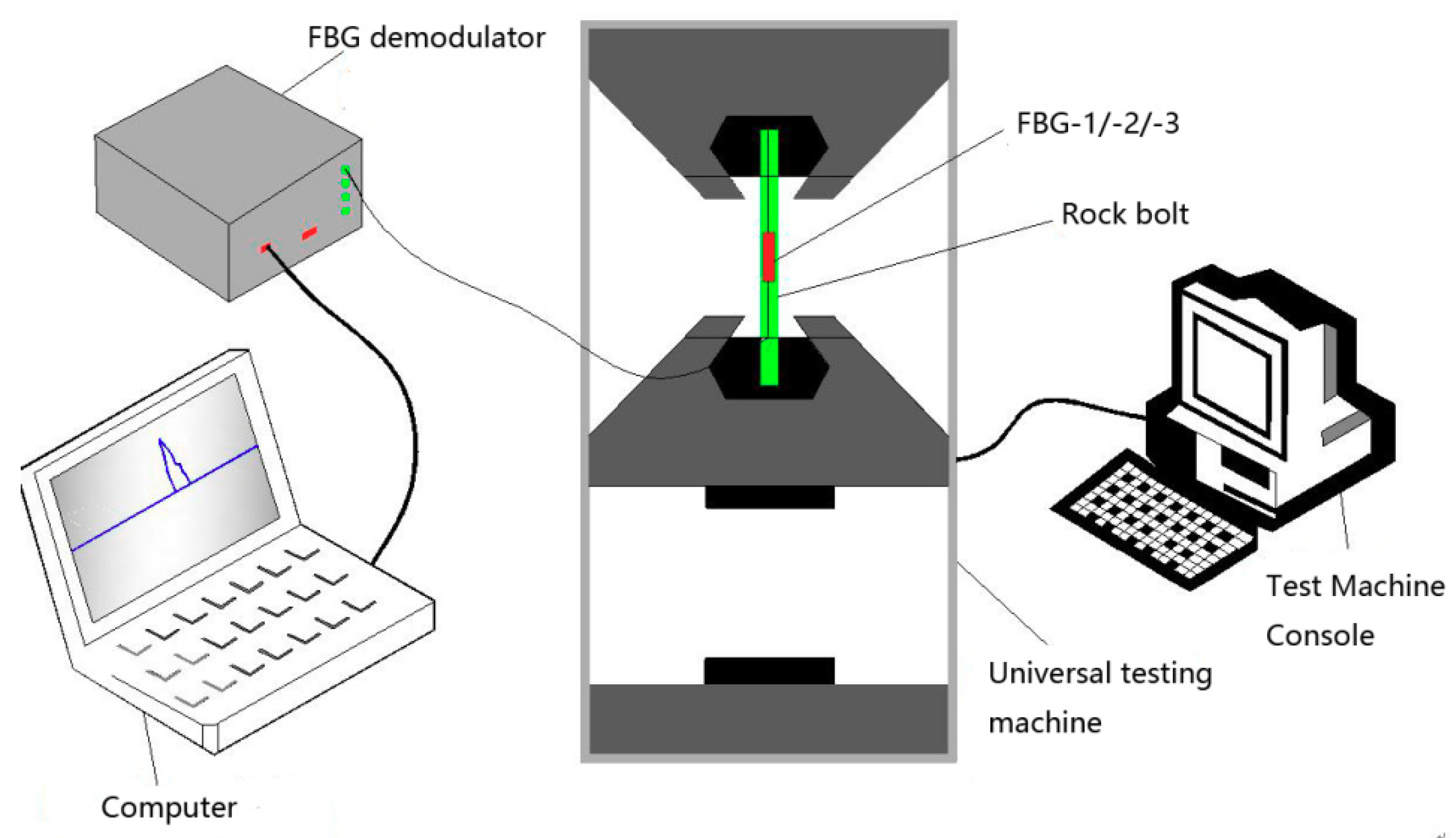

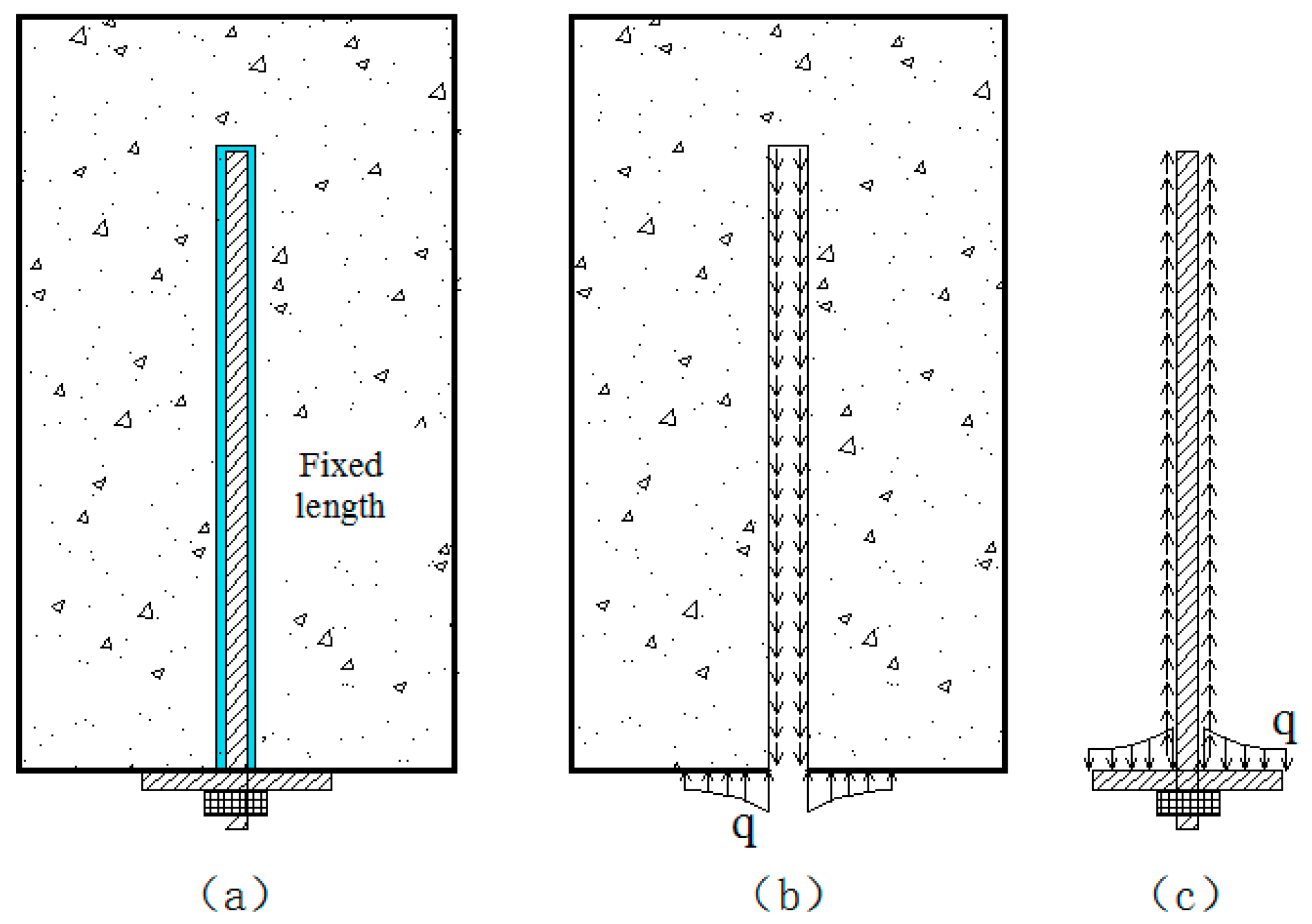






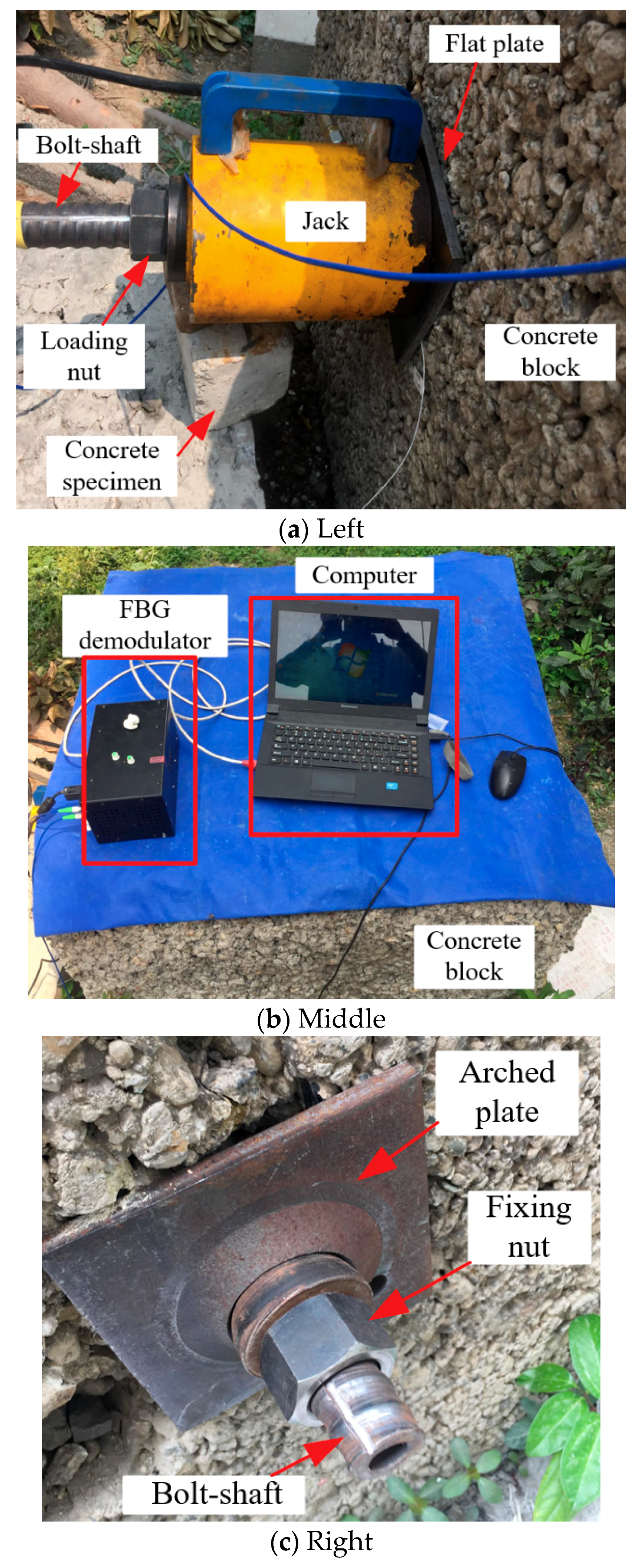


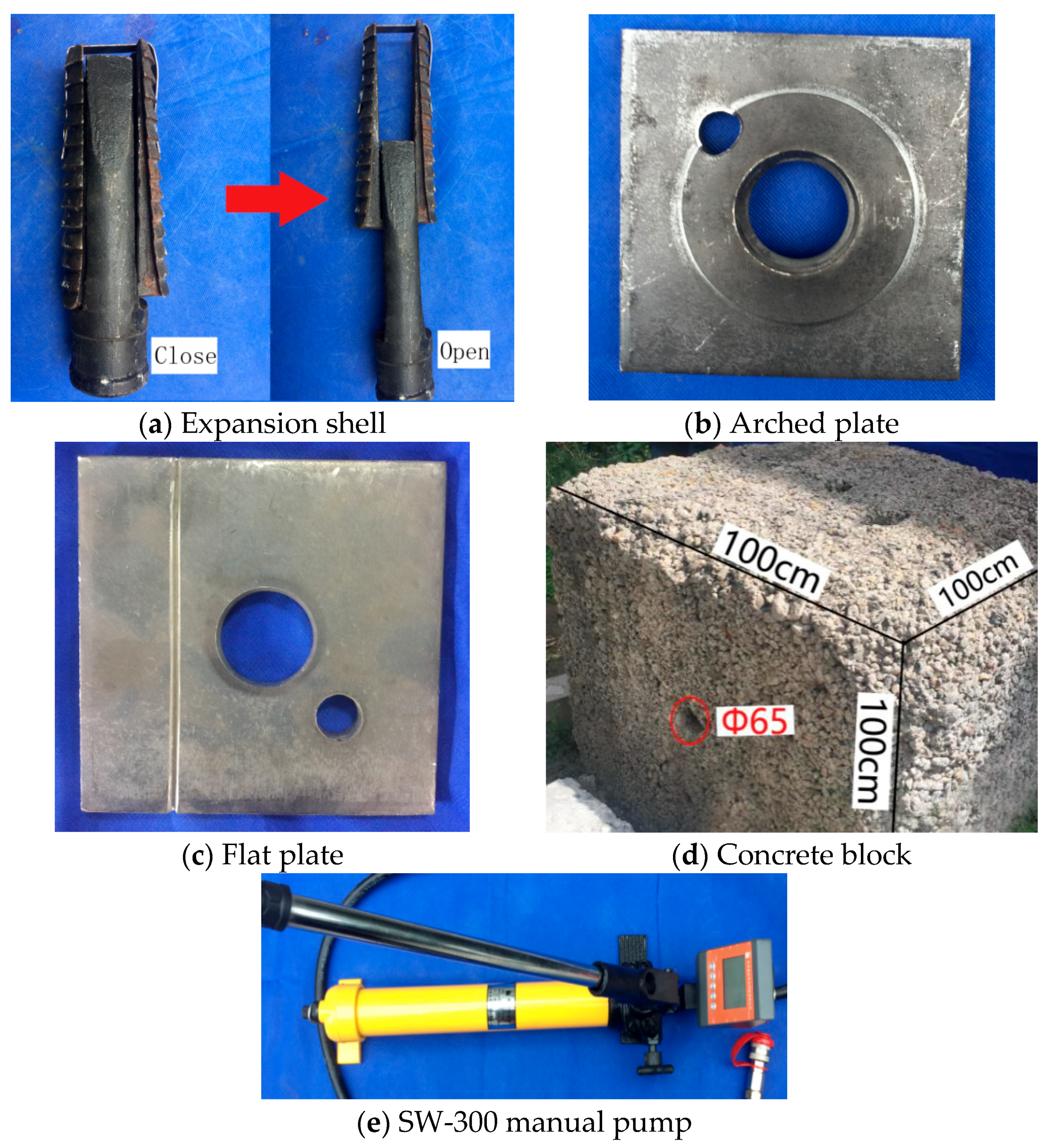

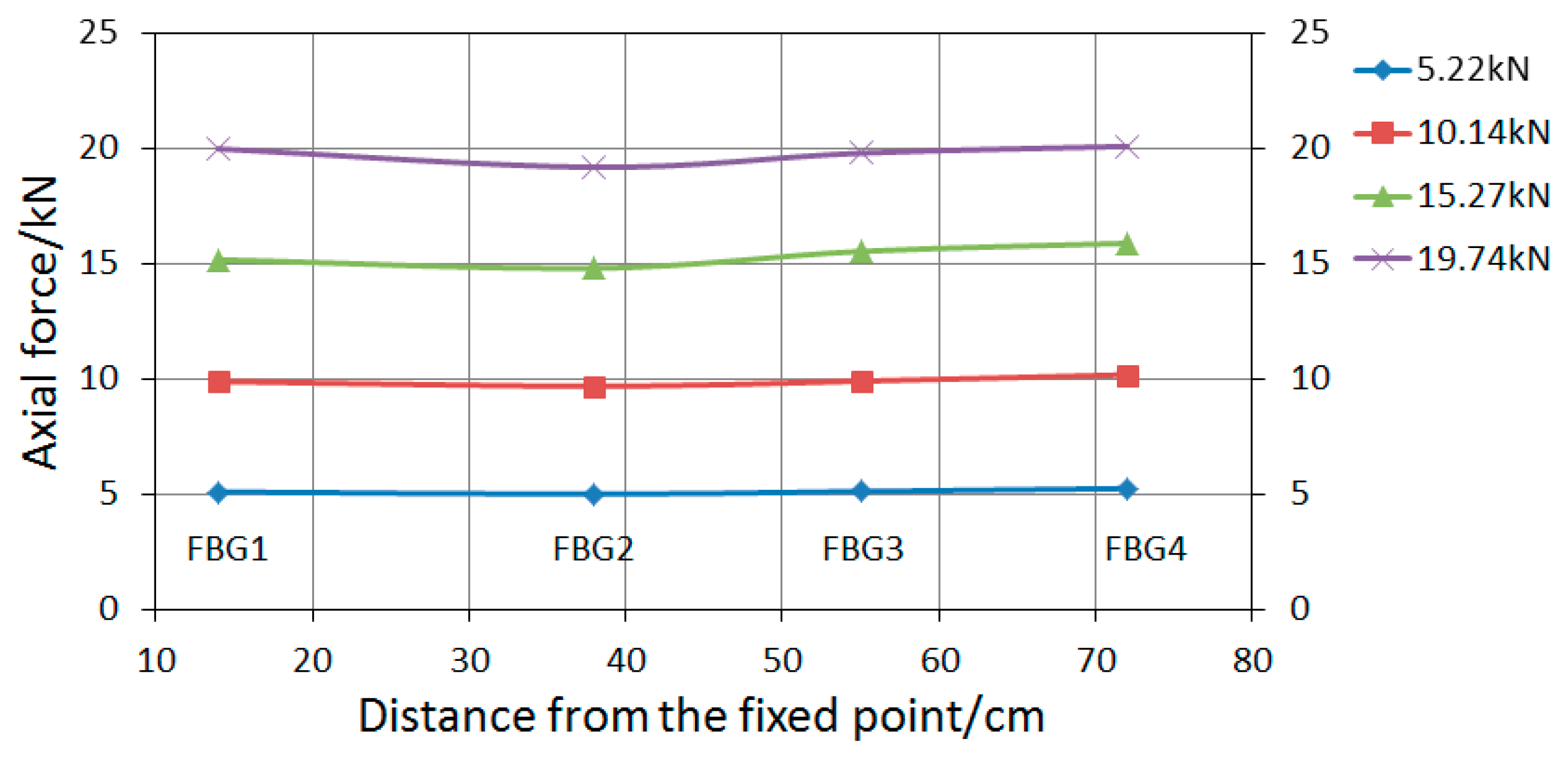
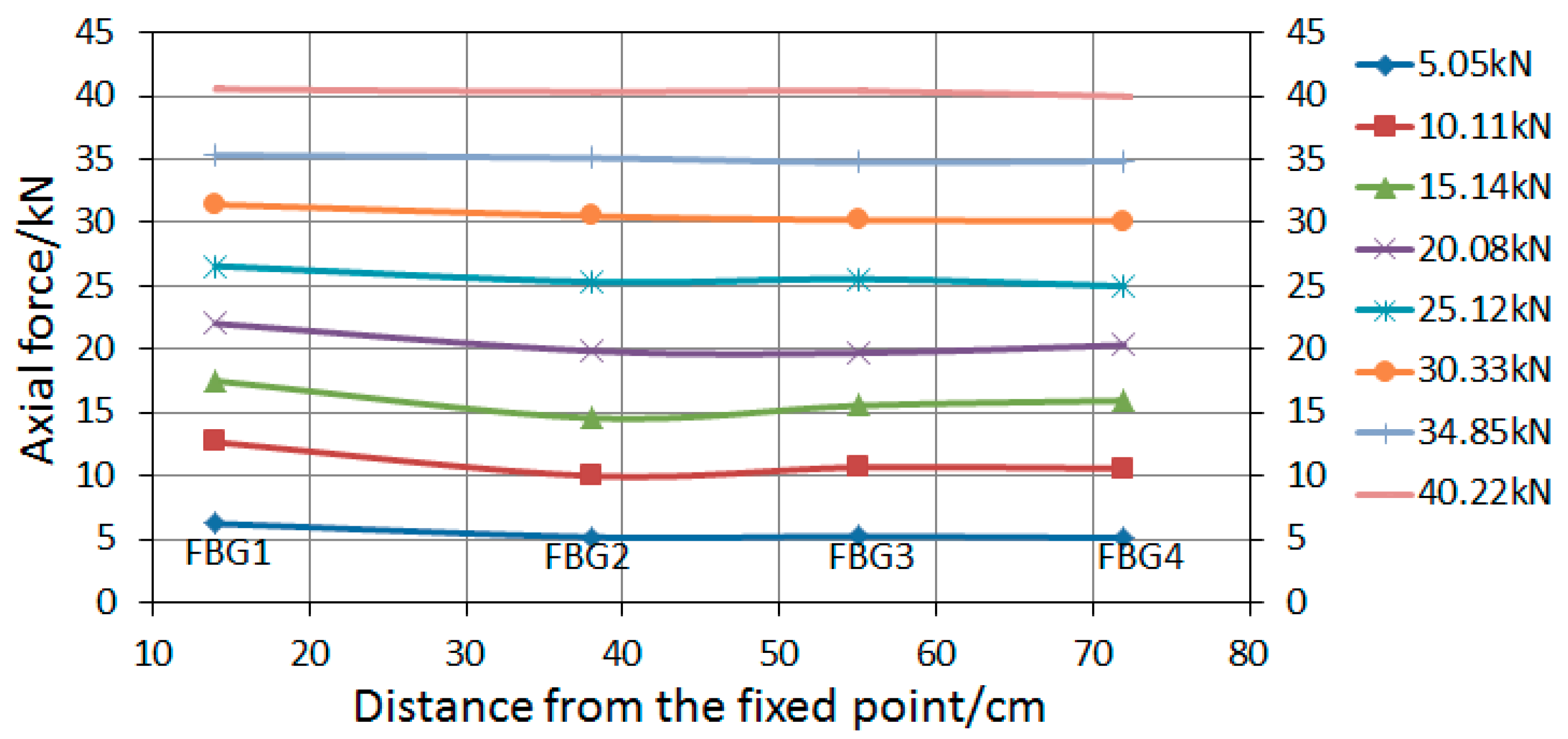
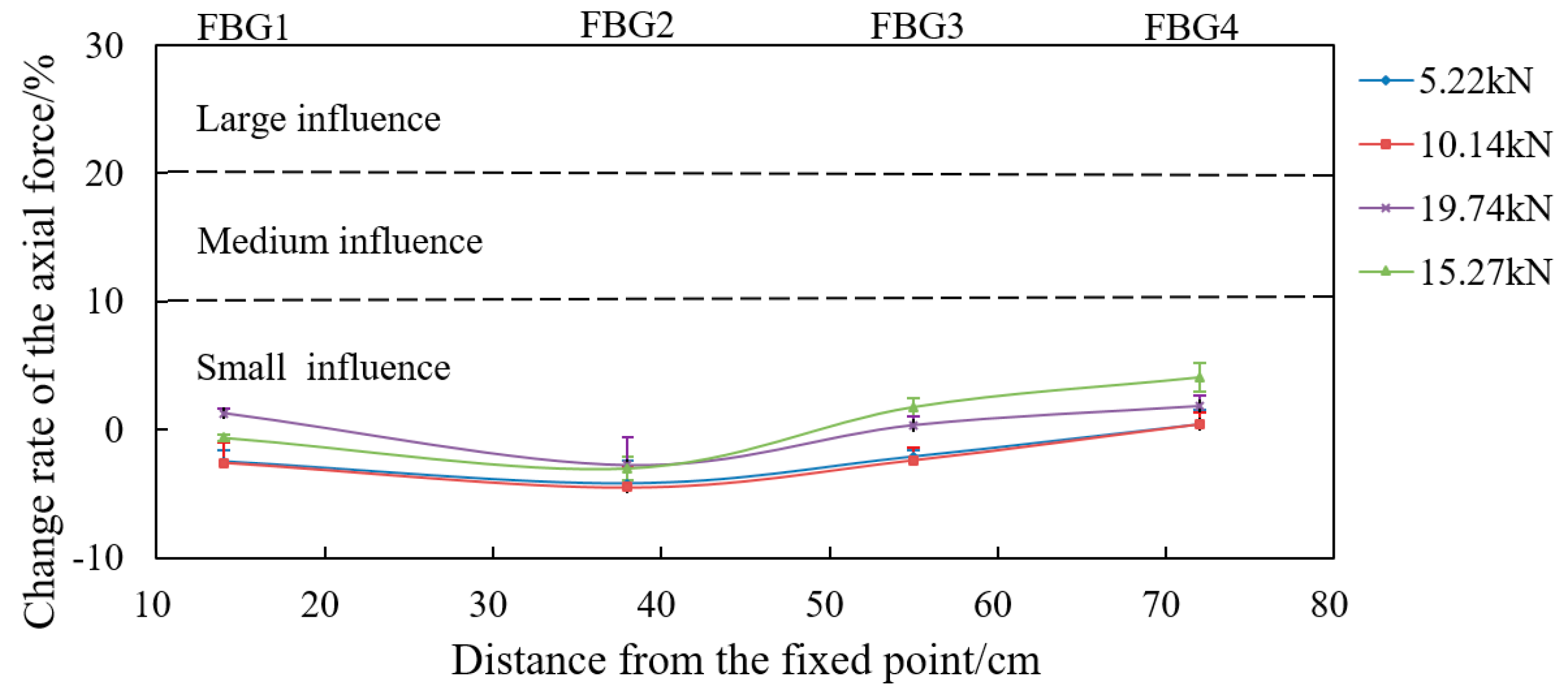

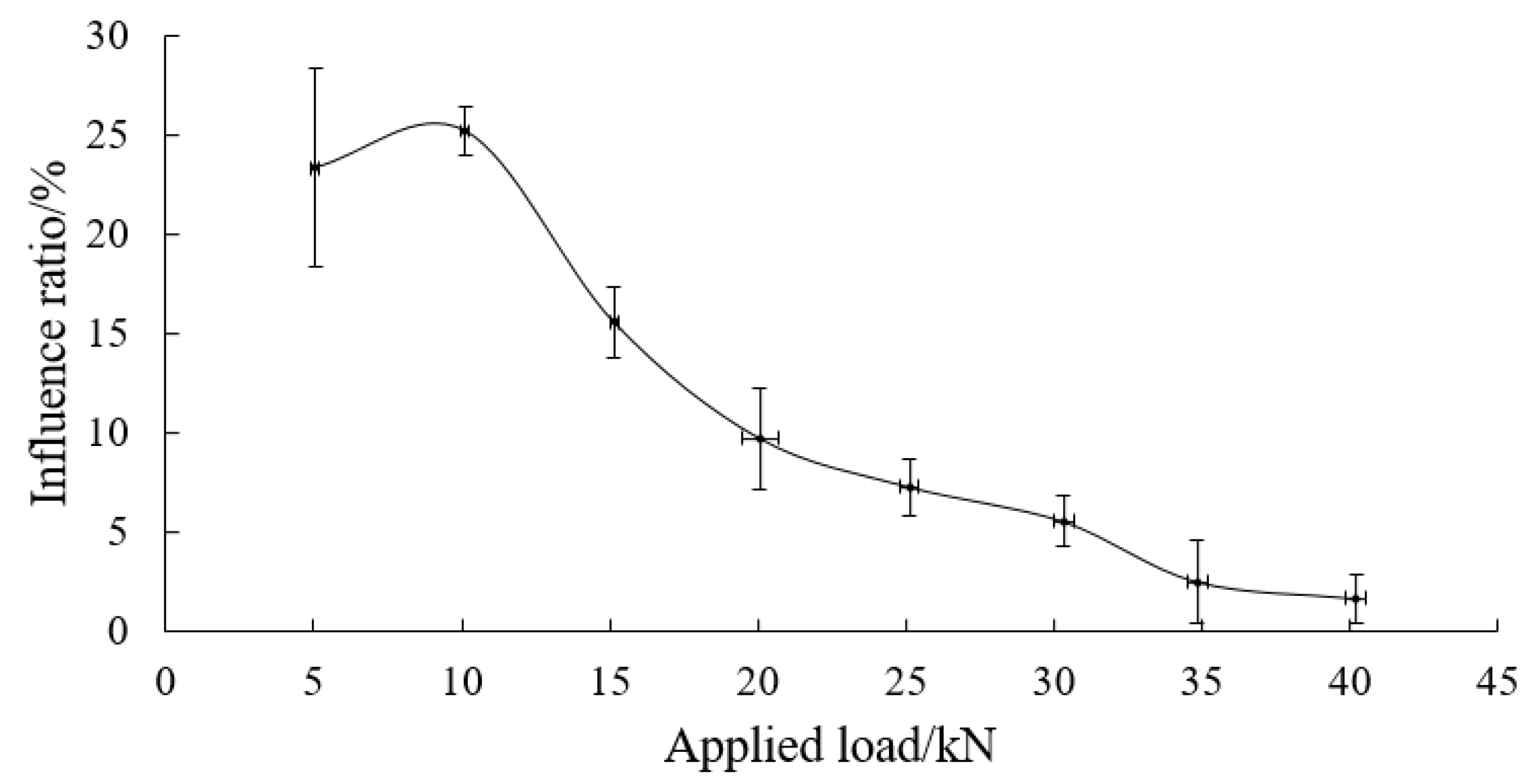
| Name | Applied Load/kN | FBG1 | FBG2 | FBG3 | FBG4 | Average | |
|---|---|---|---|---|---|---|---|
| Point Number | |||||||
| Active | 5.22 ± 0.09 | 5.09 ± 0.05 | 5.00 ± 0.09 | 5.11 ± 0.03 | 5.24 ± 0.06 | 5.11 ± 0.05 | |
| 10.14 ± 0.08 | 9.88 ± 0.16 | 9.69 ± 0.16 | 9.90 ± 0.10 | 10.18 ± 0.10 | 9.91 ± 0.13 | ||
| 15.27 ± 0.14 | 15.17 ± 0.04 | 14.81 ± 0.14 | 15.54 ± 0.11 | 15.89 ± 0.18 | 15.35 ± 0.12 | ||
| 19.74 ± 0.16 | 19.99 ± 0.08 | 19.20 ± 0.44 | 19.81 ± 0.12 | 20.10 ± 0.17 | 19.78 ± 0.20 | ||
| Passive | 5.05 ± 0.15 | 6.23 ± 0.25 | 5.16 ± 0.24 | 5.23 ± 0.28 | 5.10 ± 0.11 | 5.43 ± 0.22 | |
| 10.11 ± 0.12 | 12.66 ± 0.13 | 10.01 ± 0.21 | 10.68 ± 0.10 | 10.58 ± 0.22 | 10.98 ± 0.16 | ||
| 15.14 ± 0.13 | 17.50 ± 0.27 | 14.58 ± 0.59 | 15.55 ± 0.51 | 15.95 ± 0.46 | 15.90 ± 0.46 | ||
| 20.08 ± 0.63 | 22.03 ± 0.52 | 19.88 ± 0.87 | 19.72 ± 0.78 | 20.34 ± 0.78 | 20.49 ± 0.74 | ||
| 25.12 ± 0.32 | 26.58 ± 0.36 | 25.33 ± 0.67 | 25.56 ± 0.39 | 24.99 ± 0.51 | 25.62 ± 0.48 | ||
| 30.33 ± 0.34 | 31.44 ± 0.39 | 30.53 ± 0.68 | 30.22 ± 0.44 | 30.15 ± 0.57 | 30.59 ± 0.52 | ||
| 34.85 ± 0.35 | 35.35 ± 0.72 | 35.11 ± 0.23 | 34.77 ± 0.61 | 34.87 ± 0.51 | 35.03 ± 0.51 | ||
| 40.22 ± 0.34 | 40.55 ± 0.48 | 40.11 ± 0.44 | 40.03 ± 0.31 | 39.98 ± 0.30 | 40.17 ± 0.38 | ||
© 2019 by the authors. Licensee MDPI, Basel, Switzerland. This article is an open access article distributed under the terms and conditions of the Creative Commons Attribution (CC BY) license (http://creativecommons.org/licenses/by/4.0/).
Share and Cite
Guo, X.; Wang, B.; Ma, Z.; Wang, Z. Testing Mechanical Properties of Rock Bolt under Different Supports Using Fiber Bragg Grating Technology. Sensors 2019, 19, 4098. https://doi.org/10.3390/s19194098
Guo X, Wang B, Ma Z, Wang Z. Testing Mechanical Properties of Rock Bolt under Different Supports Using Fiber Bragg Grating Technology. Sensors. 2019; 19(19):4098. https://doi.org/10.3390/s19194098
Chicago/Turabian StyleGuo, Xinxin, Bo Wang, Zhenwang Ma, and Zhenyu Wang. 2019. "Testing Mechanical Properties of Rock Bolt under Different Supports Using Fiber Bragg Grating Technology" Sensors 19, no. 19: 4098. https://doi.org/10.3390/s19194098




